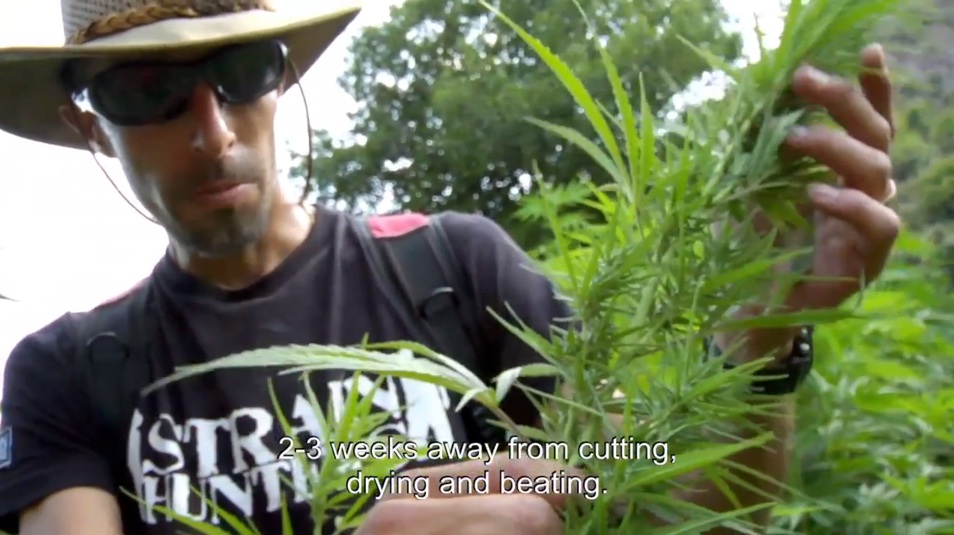
The Strain Hunters are back! In 2008 we explored the jungles of Malawi to retrieve the genetics of the original Malawi Gold, in 2009 we climbed the steep valleys of Hymachal Pradesh, India, to document the production of the finest black hashish in the world. And in 2010 we decided to continue on our quest to find the best hashish and the landraces it comes from, this time in Morocco.
The large majority of the hashish produced worldwide (up to 70% of the total annual world production) comes from a relatively small mountain region in the North of Morocco, called Rif. In Dutch coffeeshops the sales of Moroccan hashish are one of the backbones of the industry, already since the 1970s. And from London to Rome to Madrid to Cape Town, Moroccan hashish is consumed daily by huge numbers of people. Moroccan hashish was first produced after Asian and Arab merchants introduced the cannabis plant to the region, between 1000 and 1200 years ago. But it wasn't until recently (1960s) that hashish production reached export-levels, becoming the number one commercial output in the region of the Rif, and representing a significant proportion of Morocco's GDP (unofficial sources estimate it at roughly 30%).
There are social and historical reasons to this: the Berbers, inhabitants of the Rif, always maintained their independence from the Arab dynasties ruling the Country. But they were crucial in fighting European clonial powers for the formation of modern Morocco. In exchange for the help offered fighting French and Spanish troops, king Mohammed V granted the Berbers freedom to administer their land. This freedom allowed them to rapidly convert the local agricultural production (olives, figs) into cannabis production, and to produce hashish. To this day, the document granting the Berbers freedom over the Rif region is exposed in the National Museum in Marrakech.
Since the independence of Morocco from colonial powers in the 1950s, hashish has become a very sought-after commodity, especially in Europe. This demand sprouced a rapid process of organization and restructuring of local society in function of hashish producrion on a large, almost industrial scale.
Considering this background, we devoted ourselves to collect information and connect with local contacts in the spring of 2010. Strain Hunters Morocco wasn't just an idea, It now was an ongoing project, and the continuation of a great adventure.
By March I managed to reconnect with an old friend, a European working in the Rif for over 10 years, actively involved in the production of hashish. He invited me to have a look around the farms where he was working, and I did not hesitate: in the following 3 months I visited him several times, alone or with Arjan, and soon after the first trip we both agreed this would be a great chance to document the production of Moroccan hashish, and to retrieve original Moroccan genetics as well. By June, we had prepared the logistics necessary to support 2 filming trips, to be realised in July and then in September. We decided to double-up on the filming trips because of the sheer amount of material to be covered, and because in Morocco the cannabis harvest spans over an unusually large number of months, from June all the way to October. This is due to the different cannabis genetics that are cultivated in the Rif: some valleys produce original Moroccan landraces, which are semi-autoflowering and are harvested in June-July; other valleys produce genetics imported from Pakistan or Afghanistan in the 1990s that are harvested later, in September or October (these strains produce larger harvests, more resin, and ultimately a higher quality and quantity of hashish).
During both filming trips we visited two very different valleys, to be able to document different landscapes, genetics and philosophies of production. First we approached the more organized, industrial-like farmers, growing Pakistani and Afghani genetics mixed with local landraces. Then we moved on to a more remokte area, where farmers are still producing local landraces.
During the first filming trip, in July, we had the chance to see the Pakistani and Afghani genetics in full growth, while the Moroccan landrace was already being harvested. When we came back in September we witnessed the finishing of flowering of the importad genetics, as well as the manufacturing process of hashish production.
In Morocco plants are harvested, then stored to dry, slowly, for up to 1 month. Once dry, the plants are beaten on top of a set of fine screens, using sticks, so that the resin glands detach and form a brown-yellowish powder. This is called "pollen", and once pressed into bricks it becomes hashish, ready for transport and export.
Moroccan hashish available around the world is of many qualities, all different mixtures of local landrace and imported genetics. When it is made from local landeaces the hashish is light brown or yellow in color, with a dry, sandy texture; the flavor tends to be sweet and flowery, very smooth; the effect is usually mild and body-like. When Hashish is made from Pakistani or Afghani genetics it gains a dark brown color, with red hues. The aroma and flavor are intense, sweet, pungent; and the effect is usually strong, long-lasting, and very stoned. Quality also determines market price, and during the last years there has been a steady increase in the market price for stronger, more aromatic hashish. Market factors like this one are pushing Moroccan farmers to cultivate imported genetics, tather than the local ones.
During our travels in Morocco, and particularly in the Rif region, we witnessed how the farming cycle linked to hashish production is integrant part of the rural lifestyle of the Berbers, and how it dictates the rhythm of life and the rhytm of work. In the Rif children are sent to school with money from the hashish trade, and most of the population directly or indirectly benefits from it. In Morocco hashish is not a drug in the hands of criminal cartels or organized crime, it is an agricultural product that drives the local economy at all levels. Maybe this is the reason why the Moroccan government struggles between the demands of the international community (to stop the hashish production and eradicate plantations) and the demands of its own people (whose lives depend mostly on the hashish trade). It is a very delicate political and social situation, and there is no easy solution in sight. The most likely outcome is that eradication programs, already in place and sponsored by international money, will continue. At the same time it is clear that the Moroccan government has no real intentions to stop the flow of hashish towards Europe and the rest of the world.
After completing our documentary, we realised once more that cannabis is a crop that helps the poorest people of the planet in their quest to survive and to improve their quality of life.
We would like to thank our guides, and all the people of the Rif, for the help they gave realising Strain Hunters Morocco. Without them, it would have never happened.



Create an account or sign in to comment
You need to be a member in order to leave a comment
Create an account
Sign up for a new account in our community. It's easy!
Register a new accountSign in
Already have an account? Sign in here.
Sign In Now